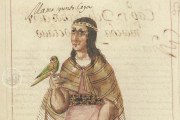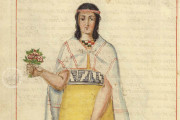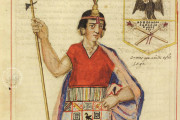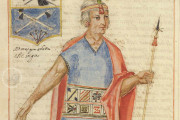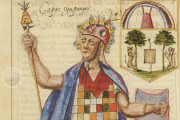The Getty Murúa is an illustrated manuscript describing the culture and history of the Inca from the establishment of the ruling dynasty to the Spanish colonial period. It is especially famous and valuable for its depictions of traditional Inca dress. Probably several years in the making mostly in colonial Peru, the manuscript was completed in 1616 in Madrid and intended as the exemplar for a printed book. Its author, Martín de Murúa, spent decades in Peru gathering accounts of the history of the indigenous peoples from the local inhabitants.
The Getty manuscript's thirty-eight illustrations include full-page portraits of the dynastic rulers of the Inca and rulers' wives, historical subjects, and coats of arms.
The Getty manuscript is the second of two surviving extensive manuscript versions of Murúa's history, the earlier being the Galvin Murúa, a manuscript that was eventually abandoned. Four paintings now in the Getty manuscript were excised from that earlier compilation, including a coat of arms of the kingdom of Peru painted by Felipe Guamán Poma de Ayala (fol. 307r).
Ceremonial Portraits
The portraits of the kings (incas) and queens (coyas) of the Inca dynasty in the Getty Murúa were created according to a European template: a standing figure in frontal or three-quarter view in royal ceremonial garb pictured on a tiled floor. Each royal figure is pictured either holding one or more objects or with an accompanying figure. The kings often hold a scepter, but there are also ceremonial shields, and—in one especially charming image—the young Pachacuti Inca Yupanqui (d. 1472) is shown with a slingshot (fol. 40v). The queens often hold flowers or a bird or small animal.
The paintings in the manuscript, both those painted for this book and those appropriated from the Galvin manuscript, are the work of indigenous artists employing many of the pigments used in dying the very textiles that are so carefully rendered in the portraits. The style of the paintings, however, is entirely European.
People, Customs, and Places
The Getty Murúa is organized into three sections. The first is a history of the Inca with a strong focus on the rulers from Manco Capac, the probably fictitious traditional founder of the dynasty, to Tupac Amaru, deposed by the Spanish in 1571. The next section is devoted to Inca institutions, rites, and customs, and the third section describes specific sites, both urban centers and sources of mineral wealth.
The text, mostly written in a self-conscious Italic script, is the work of two anonymous scribes, except for the table of contents and the title page, both the work of Martín de Murúa himself.
From Approval to Obscurity to Gift from a King
Although Murúa was successful in obtaining royal approval to create a print edition of his text, and the royal notary signed each leaf, no printed version ever appeared. It is unclear what the immediate fate of the manuscript was: it is next traceable at the Colegio Mayor de Cuenca in Salamanca in 1782. From there, it was appropriated by Charles IV (1748-1819), King of Spain, for his library in Madrid, which came into the possession of Joseph Bonaparte (1768-1844).
The English military hero Arthur Wellesley (the future Duke of Wellington; 1769-1852) seized the manuscript in 1813. It was offered to Ferdinand VII (1769-1852), King of Spain, who made a gift of it to Wellesley in gratitude for the removal of the French from Spain. It passed through the Wellesley family before being purchased by Peter and Irene Ludwig in 1979. The Ludwig collection of manuscripts was acquired by the J. Paul Getty Museum in 1983.
We have 1 facsimile edition of the manuscript "Getty Murúa": Historia General del Piru facsimile edition, published by Getty Research Institute, 2008
Request Info / Price

